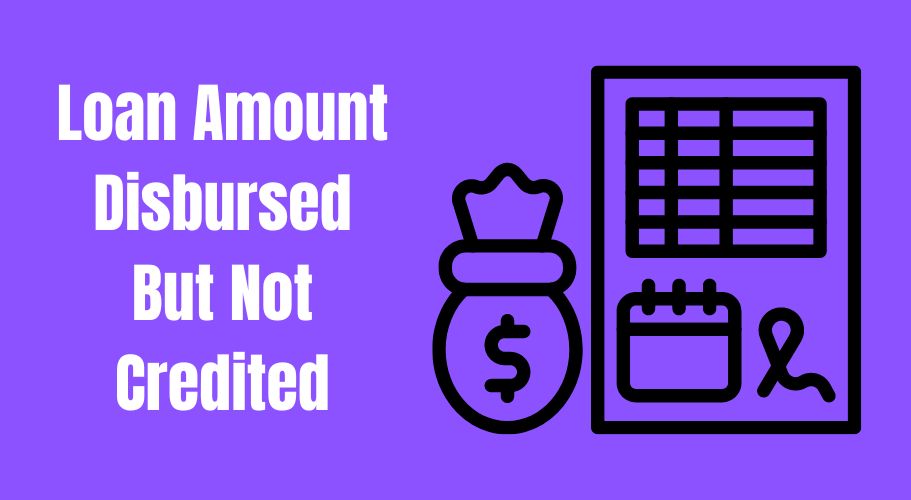What would you do if you were to take out a Personal Loan? Therefore, it is necessary to understand the disbursement process of Personal Loans and their repayment process to avoid situations where loans are disbursed but not credited. The method of disbursing Personal Loans and funding an emergency should be understood as much as possible. As a result, you will have a better chance of getting the Loan on time if you need it at some point.
Banks often disburse loan amounts to customers but do not credit them to their accounts when the Loan is disbursed. You may experience this if your account details need to be corrected, processing delays occur, you have a poor internet connection, you have a bank holiday, or your account has been frozen.
What is Loan Disbursement?
Contents

A loan disbursement occurs when a lender transfers the loan amount to a borrower’s specified bank account. Several factors are considered when a lender begins the disbursement process, including verifying and approving the borrower’s details submitted as part of the loan application process.
What are the steps involved in disbursing a Personal Loan? The lender will disburse your Loan within a specific time after approval. What is the procedure for checking loan disbursement? This section will take you through the complete Personal Loan application and disbursement process so that you can prevent situations such as a loan being disbursed but not credited.
Stages in the Loan Disbursement Process
1. Application Stage: An application for a loan is the first step in initiating the loan disbursement process. In this process, you must submit an application form and documents verifying your identity and creditworthiness. The following documents are typical:
- Identification proof
- Proof of address
- A few months’ worth of bank statements
- ITR (Income Tax Returns)
2. The Approval and Processing Stage: The bank verifies the information you provide when you submit your loan application. To assess your ability to repay your debt, financial institutions usually check your credit score, repayment history, and income-to-debt ratio.
The bank will sanction an application for a loan if you have good credit and meet other criteria. At this point, you will receive a sanction letter, which needs to be signed and returned to the lender.
3. Loan Disbursal: A direct bank deposit of the loan amount is made once all formalities have been completed. You may have to wait three or four days for lenders to review your application, but others may approve it instantly.
It generally takes two to one working days after approval for most types of loans to be disbursed. The loan amount may be deposited via check or direct deposit, depending on your bank account.
What Happens After Personal Loan Disbursement?
Loan Confirmation
Once the Loan has been disbursed, the lender will send you a confirmation letter. Generally, it is sent via e-mail or postal mail. An official confirmation letter is usually enclosed in a welcome kit.
You will receive a welcome kit with detailed information about your Loan, monthly EMIs, amortization schedule, EMI payment options, due dates, and customer support.
Loan Repayment
The loan agreement specifies how the loan amount should be repaid once you have received it. The EMI can be paid through the Electronic Clearing Service (ECS) or a post-dated check.
The bank from which you took the Loan may also allow you to set up a standing instruction that debits your EMI every month on a specified date. Ensure your monthly EMI payment is made on time, as non-payment or late payment may result in penalties and adversely affect your credit rating.
Being An Informed Borrower
A Personal Loan should always be fully understood before applying for one. Making an informed decision will make it easier for you to make a good one. Take a critical look at the borrower’s charges and terms before accepting them.
You should understand them thoroughly and try to negotiate a lower interest rate. Avoid making any errors in loan documents by checking them thoroughly, especially the interest rate, penalties, and repayment options.
Common Issues and Solutions of Loan Amount Disbursed But Not Credited
What should you do if your bank approves your loan application and completes all the required paperwork but still needs to credit your account with the loan amount?
1. Talk to the Loan Officer. If the funds have not been released after your Loan has been approved, your loan officer should be contacted immediately. Their assistance can expedite the process and provide the necessary assistance.
2. Prepare the Documents in Advance. Ensure you have all necessary documents, such as loan application numbers, Aadhaar numbers, and account statements. Providing this information will help the loan officer verify your details as quickly as possible.
3. Check the Sanction Letter. Review the sanction letter closely to ensure all conditions have been met. Depending on the conditions, banks may disburse the loan amount at the end of the month but not release it if specific requirements are unmet.
The following conditions are expected:
- The latest property tax receipt
- An original list of property documents from existing banks
- Letter from existing bank regarding foreclosure
- The authority must approve a mortgage on a leasehold property
- Approvals from within the bank
Monitoring these details is essential to prevent delays and ensure funds can be credited on time. Even if the disbursed amount has not been used, interest may be liable, so it’s important to comply with all sanction requirements as soon as possible.
4. Consider Legal Assistance: If there is no satisfactory resolution, you may consider hiring a lawyer.
Reasons Lenders Can Withhold Loan Disbursement
The following reasons might cause banks to withhold loan disbursement after sanctioning:
Aspects of Property Valuation: The property value may be less than the loan amount approved.
Disputes in Law: There might be legal disputes concerning the property documents.
Personal and Professional Details: Discrepancies in your personal and professional information.
Builder Issues: The builder might be blocked or not approved by the bank.
FAQs
What is the duration of Loan Disbursement?
There is a range of 1 to 2 working days between when loans are disbursed. There may be differences between lenders, however.
Can a Loan be Disbursed on Weekends?
It is possible to disburse loans on weekends, but you may not receive credit until the following business day.
What is the Procedure for Loan Disbursement?
Loan agreements provide for transferring loan amounts from the lender to the borrower. When a loan is successfully secured, the total loan amount is transferred to the borrower.
How Long Does it Take for a Loan to be Credited After Disbursement?
The loan amount is generally credited within 1-3 business days, although bank processing times and lender policies may vary.
Conclusion
Borrowers need to understand how loans are disbursed and the possible reasons for delays in crediting disbursed amounts. If your loan amount has been disbursed but has yet to be credited, prompt action and clear communication with your lender and bank are critical steps to ensure a swift resolution.













Add Comment